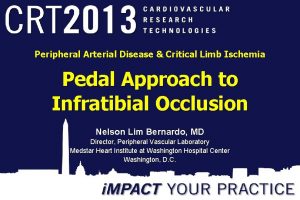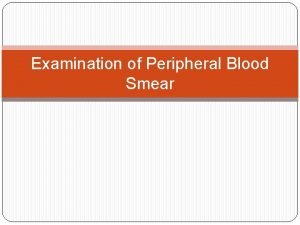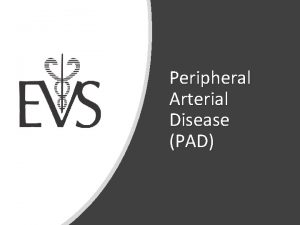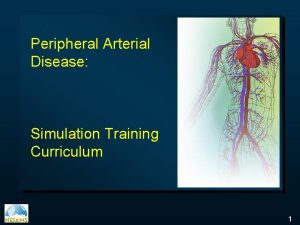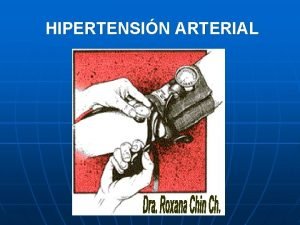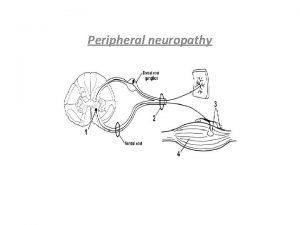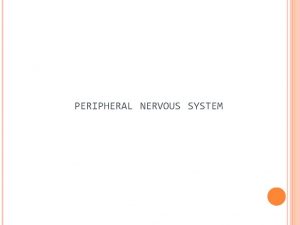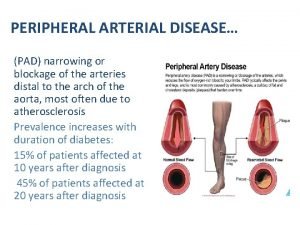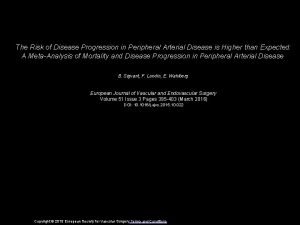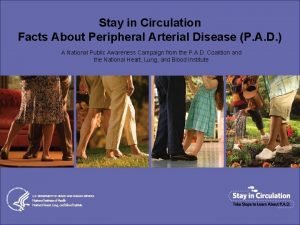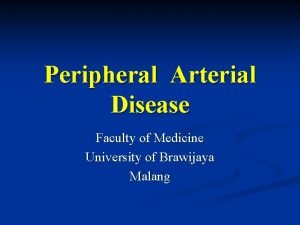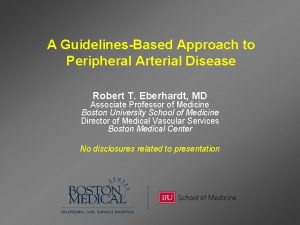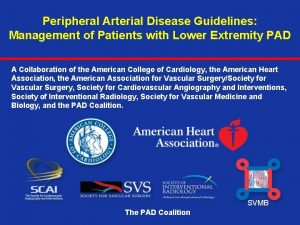Special Report Peripheral Arterial Disease Lack of Awareness




















- Slides: 20

Special Report Peripheral Arterial Disease: Lack of Awareness in Canada The First Canadian P. A. D. Public Awareness Survey Peripheral Arterial Disease: Lack of Awareness in Canada. Canadian Journal of Cardiology, 2009, in press

Contributors Marge B. Lovell, RN Kenneth Harris MD Thomas Forbes MD Beth Abramson MD Gwen Twillman Paul Schroeder, MA Michael H. Criqui, MD, MPH Emile R. Mohler, III, MD Alan T. Hirsch, MD on behalf of the Peripheral Arterial Disease Coalition

National P. A. D. Public Awareness Survey Background • Lower extremity peripheral arterial disease (P. A. D. ) is common, affecting up to 12% to 29% of the elderly and approximately 800, 000 Canadians. • Intermittent claudication is the most frequent symptom of P. A. D. and impairs quality of life and functional status. • Individuals with P. A. D. suffer a 5 -fold increased relative risk of a heart attack and stroke and total mortality that is 2 -3 fold greater than those without P. A. D. • Individuals with P. A. D. suffer combined annual rates of heart attack, stroke, and hospitalization that are comparable to, or greater than, rates observed in individuals with established coronary artery disease or stroke. • … but if the public is not aware of this risk, how can the risk be lowered?

National P. A. D. Public Awareness Survey Objectives • Obtain baseline data to quantify public knowledge of the causes (risk factors), symptoms, and ischemic risks to life and limb of P. A. D. • Results intended to serve as a benchmark so that improvements in awareness can be documented over time. Peripheral Arterial Disease: Lack of Awareness in Canada. Canadian Journal of Cardiology, 2009, in press

National P. A. D. Public Awareness Survey Methods • 10 -minute telephone survey used a Random Digit Dialing (RDD) sampling procedure to draw a national probability sample • Survey administered to: National cross-section of 501 Canadians ages 50+ years • Conducted from 6/5/2006 to 7/5/2006 • Interviews were conducted in English and French • Results were weighted by age and gender to reflect 2006 Canadian census estimates Peripheral Arterial Disease: Lack of Awareness in Canada. Canadian Journal of Cardiology, 2009, in press

The Survey Population Demographics Total Sample, n (%) 501 (100) Gender Male Female 233 (46. 4) 268 (53. 6) Age 50 -59 60 -69 70 -79 80+ 209 (41. 6) 136 (27. 2) 103 (20. 6) 53 (10. 5) Race White Black Aboriginal Asian Other Peripheral Arterial Disease: Lack of Awareness in Canada. Canadian Journal of Cardiology, 2009, in press 466 (93) 3 (0. 7) 8 (1. 6) 10 (1. 9) 8 (1. 6)

The Survey Population Demographics Total Sample, n (%) 501 (100) Education 301 (60. 1) 194 (38. 7) 233 (46. 6) 192 (38. 3) Income Peripheral Arterial Disease: Lack of Awareness in Canada. Canadian Journal of Cardiology, 2009, in press ≤ High School > High School < $40, 000 ≥ $40, 000

The Survey Population Demographics Risk Factors and CV Diseases Risk Factor or CVD Percentage High blood pressure 43. 4 High cholesterol 36. 7 Diabetes 12. 0 Smoking History Current 18. 2 Past 40. 5 Never 41. 1 Chest pain or angina 18. 2 Heart attack 10. 0 Coronary bypass surgery or angioplasty 7. 6 Stroke 4. 2 Mini-stroke or TIA 5. 8 Carotid artery surgery or stenting 1. 8 P. A. D. Peripheral Arterial Disease: Lack of Awareness in Canada. Canadian Journal of Cardiology, 2009, in press 0

P. A. D. Symptoms Percentage of respondents Do you currently have ___ ? Peripheral Arterial Disease: Lack of Awareness in Canada. Canadian Journal of Cardiology, 2009, in press

Key Findings

Two Out of Three Adults Surveyed Are Not Familiar with P. A. D. How familiar are you with P. A. D. : very familiar, somewhat familiar, not too familiar or not at all familiar? Not Aware of P. A. D. (64%) P. A. D. Aware (36%) “P. A. D. Aware” defined by “somewhat” or “very familiar” responses Peripheral Arterial Disease: Lack of Awareness in Canada. Canadian Journal of Cardiology, 2009, in press

P. A. D. Awareness Is Markedly Lower Than Other Cardiovascular Diseases and Risk Factors How familiar are you with the following conditions: very familiar, somewhat familiar, not too familiar or not at all familiar? High blood pressure 80 High cholesterol 79 74 Diabetes 72 Stroke Coronary artery disease 51 Congestive heart failure 48 P. A. D. 36 Percentage very or somewhat familiar Peripheral Arterial Disease: Lack of Awareness in Canada. Canadian Journal of Cardiology, 2009, in press

P. A. D. Awareness by Age and Gender 37 23 33 Peripheral Arterial Disease: Lack of Awareness in Canada. Canadian Journal of Cardiology, 2009, in press % very or somewhat familiar How familiar are you with P. A. D. : very familiar, somewhat familiar, not too familiar or not at all familiar? 32 39

How familiar are you with P. A. D. : very familiar, somewhat familiar, not too familiar or not at all familiar? 46 29 Peripheral Arterial Disease: Lack of Awareness in Canada. Canadian Journal of Cardiology, 2009, in press % very or somewhat familiar P. A. D. Awareness by Education and Income 31 23 40 32

Perceived Causes of P. A. D. Among Those “P. A. D. Aware” Does ____ increase the risk of getting P. A. D. not at all, a little, some, a moderate amount or a lot. Combined Responses: A Lot & Moderate Amount 58 Cigarette smoking Overweight 57 55 Lack of exercise High blood pressure 51 Diabetes 51 High cholesterol Heart attack or stroke 49 44 Personal history MI/stroke 37 Drinking alcohol Peripheral Arterial Disease: Lack of Awareness in Canada. Canadian Journal of Cardiology, 2009, in press 36 Percentage

Perceived Consequences of P. A. D. Among Those “P. A. D. Aware” % of “P. A. D. Aware” respondents Based on what you know or have heard, what can P. A. D. lead to if not treated? 21 21 20 12 7 6 2

Few Canadians First Learn About P. A. D. through Health Care Providers At Work (5%) TV (28%) Other (15%) Family & Friends (18%) Magazine/ Newspaper (15%) Health Care Provider (19%) Internet (3%) Peripheral Arterial Disease: Lack of Awareness in Canada. Canadian Journal of Cardiology, 2009, in press Radio (1%)

Conclusions • Few (about two in three) Canadians are aware of P. A. D. • Those Canadians at risk for P. A. D. do not know its causes and thus cannot take steps to prevent it. • Few Canadians know that having P. A. D. markedly increases one’s short-term risk for heart attack, stroke, amputation and death. • Those who are aware of P. A. D. rarely first learn about it from health care providers.

Conclusions • P. A. D. -related knowledge is far below that of other comparable or lower risk cardiovascular diseases. • These findings reinforce the need for national educational efforts on P. A. D. • Health professionals, the media, the healthcare industry, and government agencies share a responsibility to work together to inform the public about this common cardiovascular disease.

The P. A. D. Coalition • The P. A. D. Coalition aims to deliver consistent, evidence-based P. A. D. messages to the public and the health care community. • New tools are available to help medical practices, hospitals, health plans and health systems educate their patients and clinicians about P. A. D. • Visit www. PADCoalition. org
 Peripheral arterial disease
Peripheral arterial disease Peripheral arterial pulse sites
Peripheral arterial pulse sites Privacy awareness and hipaa awareness training cvs
Privacy awareness and hipaa awareness training cvs Vascular bundles definition
Vascular bundles definition Jnc 7 hypertension
Jnc 7 hypertension Communicable disease and non communicable disease
Communicable disease and non communicable disease Snowplow effect in blood smear
Snowplow effect in blood smear How to write a comprehensive report
How to write a comprehensive report Special incident report
Special incident report Modal obligation
Modal obligation Communication between parents and teenagers
Communication between parents and teenagers Prqrt method
Prqrt method A lack of voluntary consent:
A lack of voluntary consent: Reuptake of neurotransmitters
Reuptake of neurotransmitters Lack of diversification
Lack of diversification Roxanne borja sex
Roxanne borja sex Overconsumption of fat
Overconsumption of fat Causes of teenage pregnancy
Causes of teenage pregnancy Lack of unity
Lack of unity Lack of cohesion of methods
Lack of cohesion of methods Your child's success or lack of success
Your child's success or lack of success
